Space Shuttle Launch Complex 39-B Construction Photos
Page 13
PGHM Bridge Beam Lift, Page 2 (Original Scan)
Ok then, on this page you can see how they're going about it. Lift it up, get it in the PCR Doors opening, and then just kind of suck it on up in there at an angle. Imagine somehow getting your automobile into the upstairs hall closet, without so much as scratching the car or any portion of the entire house, and you've kind of got an idea of what was involved here. Except, of course, the floor of your house isn't suspended ninety feet in the air, and your automobile isn't fifty feet long and doesn't weigh a hundred tons, or whatever the PGHM bridge beam actually weighed.
Additional commentary below the image.
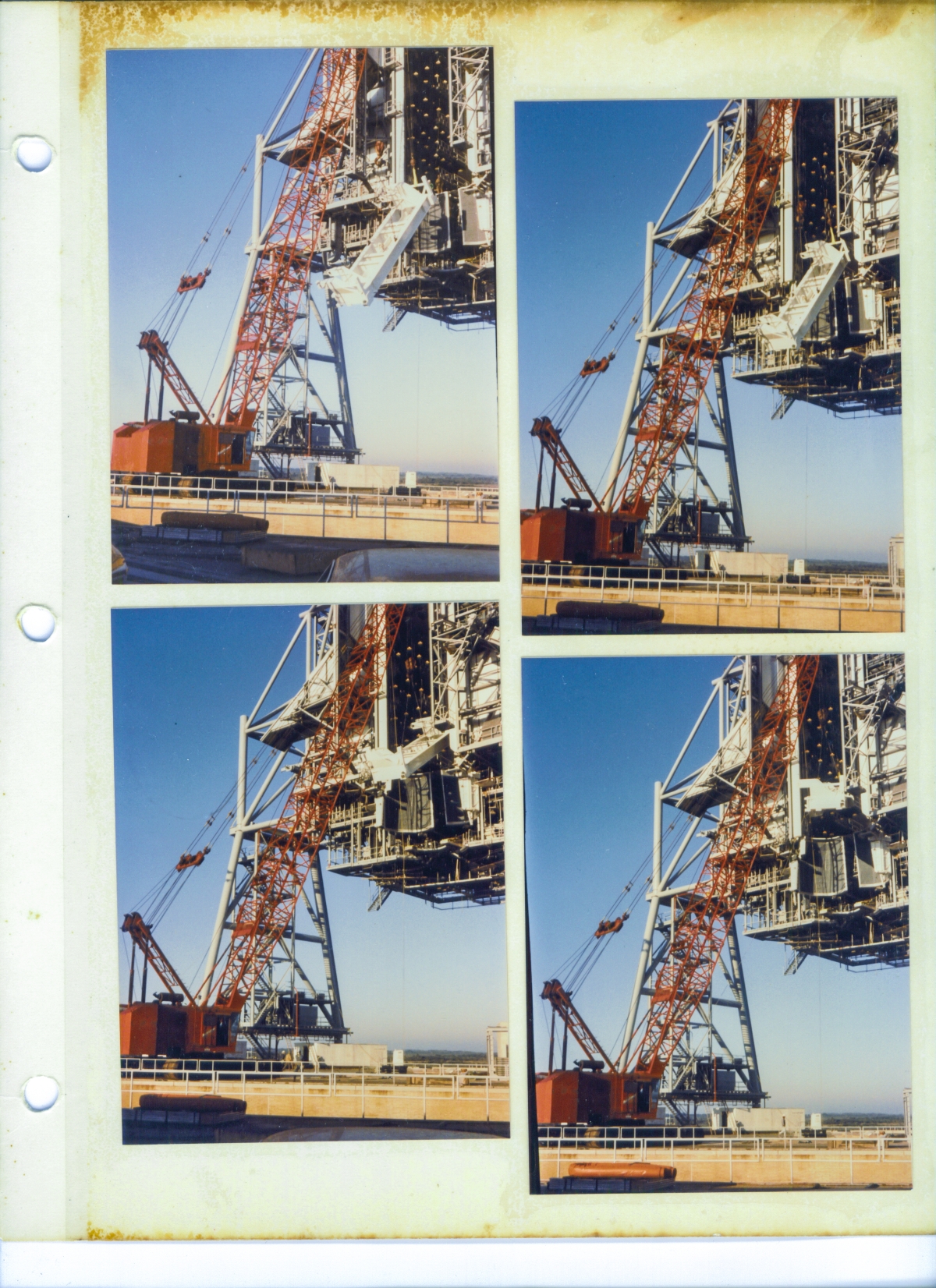
Top Left: (Full-size)
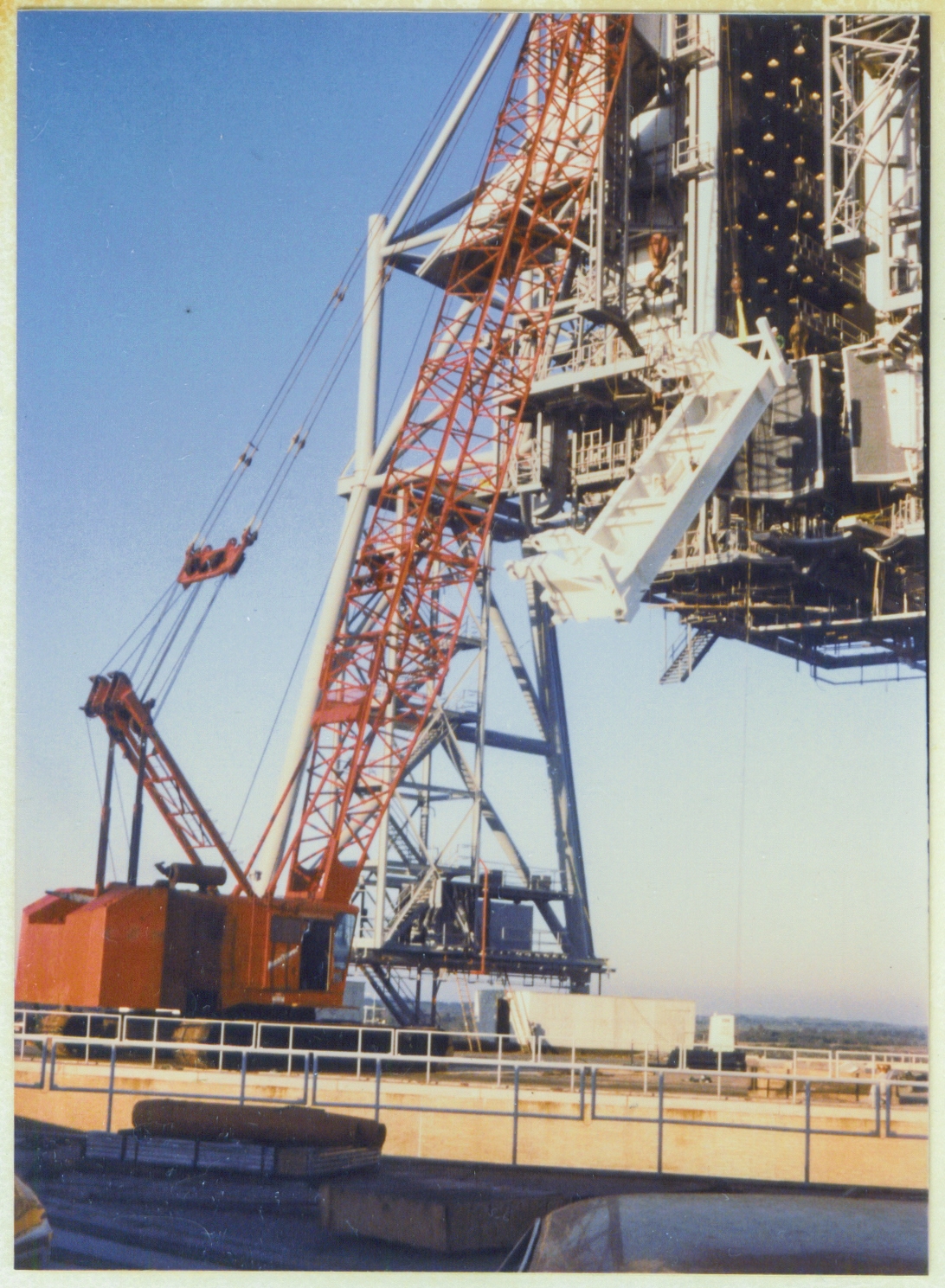
Ok, the top of the bridge beam is closing in on the lower edge of the opening to the Payload Changeout Room. The PCR Doors, which, as is so much else out here, are ridiculously outsize, standing sixty-five or seventy feet tall, are folded inside and completely out of the way, and we can see some fairly good detail inside of the PCR itself. Time to zoom way the hell in on the image. Give it 200 or even 300 percent. It'll be blurry at that magnification, but you'll be able to see and distinguish things I'll be talking about that you might not otherwise be able to, ok?
There's a couple of ironworkers visible at the top of the bridge beam, near the edge of the 135' PCR floor steel, 90 feet of free and clear drop to the unfeeling concrete of the pad deck beneath them. Please notice how the bridge beam has regained all of its previous size and mass, now that there's a couple of people back in the frame with it. Weird, huh? And, now that I'm mentioning this effect again, presuming you're still zoomed in somewhere around 300 percent and this image is completely filling your screen, also please notice just how much the RSS has swelled in size too, with this pair of ant-like ironworkers there, smack-dab in the middle of things, to give you some proper perspective on things. Do you want to hear me talk about how fucking big that RSS is? No? Ok, I'll give it a rest. For now, anyway.
On the right, one of our ironworkers, partially obscured by the shadows of the crane boom and lifting gear, is dressed in drab orange coveralls, wearing a red hard hat, and he's pretty damned close to the edge of the PCR floor steel. Our other ironworker, dressed in a green shirt and blue jeans, wearing a white hard hat, and mostly obscured by the large post at the top-right corner of the bridge beam, has stepped off, and is no longer even on the floor steel, and is instead standing on the suspended bridge beam, on a tiny ledge which protrudes out just enough to carry his boots, on the far side of that post. From this point of view, that ledge is invisible, but there is a similar ledge at the bottom of the post down at the bottom-right corner of the bridge beam, and you can zoom on in with it until you get a feel for what this man has just, as a matter of course in the day-to-day conduct of his duties, decided is a good place to step across to, and trust his life with. You'll grow tired of hearing me say it in these essays, but I do not care. There is no possible way to give these people the respect which they are due. No way. None at all.
Above and behind our ironworkers, the interior of the PCR has come into fairly good view, and now you can see pretty clearly that it's not an open space in there at all, but is instead filled up with the PCR Interior Platforms. There's five levels of those platforms in there, crowding toward the center on both sides, and yet somehow this bridge beam is going to be threaded in, between them and above them, and laid sideways just beneath the ceiling of the PCR, with a clear span that's as wide as the entirety of the whole platforms-set system, abovewhich it will finally come to rest horizontally, with stupidly tight clearances, all along, all the way around, all the way to the end of the line. I can only imagine some of the conversations between Wade and Rink as they measured, walked, looked, considered, measured some more, walked some more, looked some more, considered some more, and finally decided that yes, yes we can do this, but it's going to be close! We're talking real money here in crane time and ironworker time, not to mention possible backcharges from any of the other craft labor who had to be shooed away, out of the area, while this lift was in progress. Notice the complete lack of other people on the tower and on the ground. Nobody sticks around when a lift like this is going down. Nobody except the people actually doing the lift, that is. And if this lift had turned out to be impossible because of some damnable unseen, unknowable, thing, and the goddamned bridge beam had to be sucked back out of the PCR and laid back down on the ground, now you get to try and figure out how to get the sonofabitch back in there, some different way. But it all worked out right the first time, and stands as yet one more reminder of the stratospheric level of talent and confidence required to get this work done, by all parties concerned.
Top Right: (Full-size)
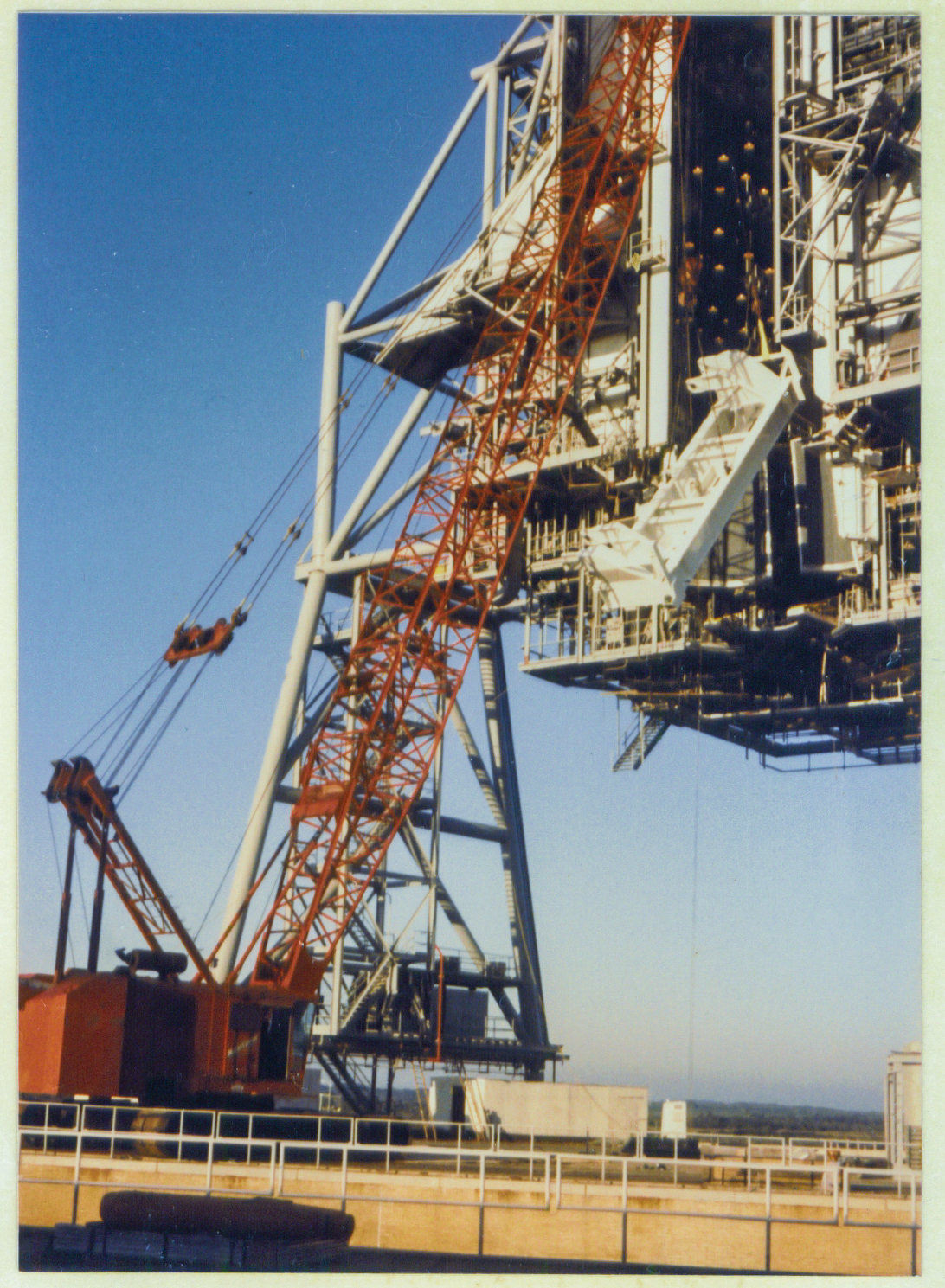
The bridge beam is ever-so-slowly being drawn into the interior of the Payload Changeout Room. Neither one of the ironworkers visible in the previous image can be seen. I do not know if they are still right there, one on the beam and one still on the PCR floor steel, obscured by the bridge beam, or if one, or both, of them has departed, on their way to perform other tasks in other places.
Look close, and you can see that our crane operator has boomed down some, despite the fact that there's a whole world of unyielding iron up there out of frame, all around the boom of his crane at very close quarters, and as he's booming down (which is of course bringing both the jib line and the main hoist line closer and closer to the envelope of the RSS), he's coming up on his lines, to keep the bridge beam either at the same level, or to continue to gain elevation with it, and if that's not enough, the jib line has to come up just a trifle less than the main hoist line, because he's also by now right in the middle of leveling the bridge beam just a little, to get it inside of that goddamned PCR at just the right angle, and godDAMN this is some ticklish fucking work the guy's doing right now! Meanwhile, back in a world solely-populated by much lesser mortals, you can't even handle parallel-parking your own fucking car.
And since I don't know where else to bring it up, I'm now going to direct your attention (still nice and zoomed in, yes?) to the innocently-named "MLP Access Stairs."
Cast your gaze downward, directly below the bottom end of the bridge beam, until you run out of steel and start seeing nice blue sky down there. Hmmm... looking down to see the sky. Boy... I dunno. Anyway, there's some steel sticking down and to the left against the background of that pretty blue sky down there, and that steel is a stairway, and you can walk right on down to the bottom riser if you want to, but I wouldn't recommend it, because there's nothing there to step on to at the bottom of that stair other than a direct free-fall drop of a little over fifty feet, through thinnest air, down on to the hard and uncaring concrete surface of the pad deck.
Welcome to the MLP Access Stairs. There's two of 'em, one on either side of the RSS, but you can't see the other one in this image, 'cause it's out of frame to the right.
What the fuck?
Well, the RSS moves, right? And when it's rotated around into the mate position, these stairs would then be located directly above the yawning gulf of the flame trench, which still doesn't seem to make any kind of sense, except for the fact that the RSS is almost never swung around into the mate position unless the MLP has been rolled out, with or without a Space Shuttle sitting on top of it, and parked on its support pedestals, and when the MLP is sitting there, this stair no longer goes to nowhere, but instead permits you to step sweetly down on to the half-acre extent of the MLP deck as though you were coming off of the last step from your upstairs bedroom area down onto the floor in your living room.
But when the MLP's not there, or when the RSS is in the de-mate position..... it becomes a little more interesting.
These stairs have a couple of surprisingly-flimsy little hinged "safety" gate affairs (we furnished and installed 'em exactly as instructed per the approved plans and specifications) at their top and bottom landings, but never in my life would I so much as dream of putting any actual weight against them, and really, that wouldn't even be required to give yourself a dire problem anyway, 'cause if you took a poorly-chosen location to stumble and fall on the stair, you'd just keep going, right on through, underneath the gate, and off into the oblivion waiting patiently below.
But it was fun to walk down to the bottom of those stairs, and I did so far more often than mere work dictates would have indicated, and it's kind of cozy down there with nobody anywhere near you beneath the great dark looming canopy of the RSS blotting out the sky up above you, and a really nice view all the way out to the ocean and all around the pad area itself from a very unique elevated location that was close, but not too close, to all kinds of neat stuff.
Why these stairs weren't designed as retractable with perhaps a hinge on their top connection to the main platform framing at the 112' elevation which would allow them to simply be retracted up into the flooring of the RSS and locked into place, and by so doing completely block the opening, I'll never know. I'm sure they had a reason, but I'm equally sure I'll never know why. Maybe it was to keep from bumping somebody who was mindlessly walking around on the MLP deck, right on their head or something, when they lowered the stairs.
Who knows?
Bottom Left: (Full-size)
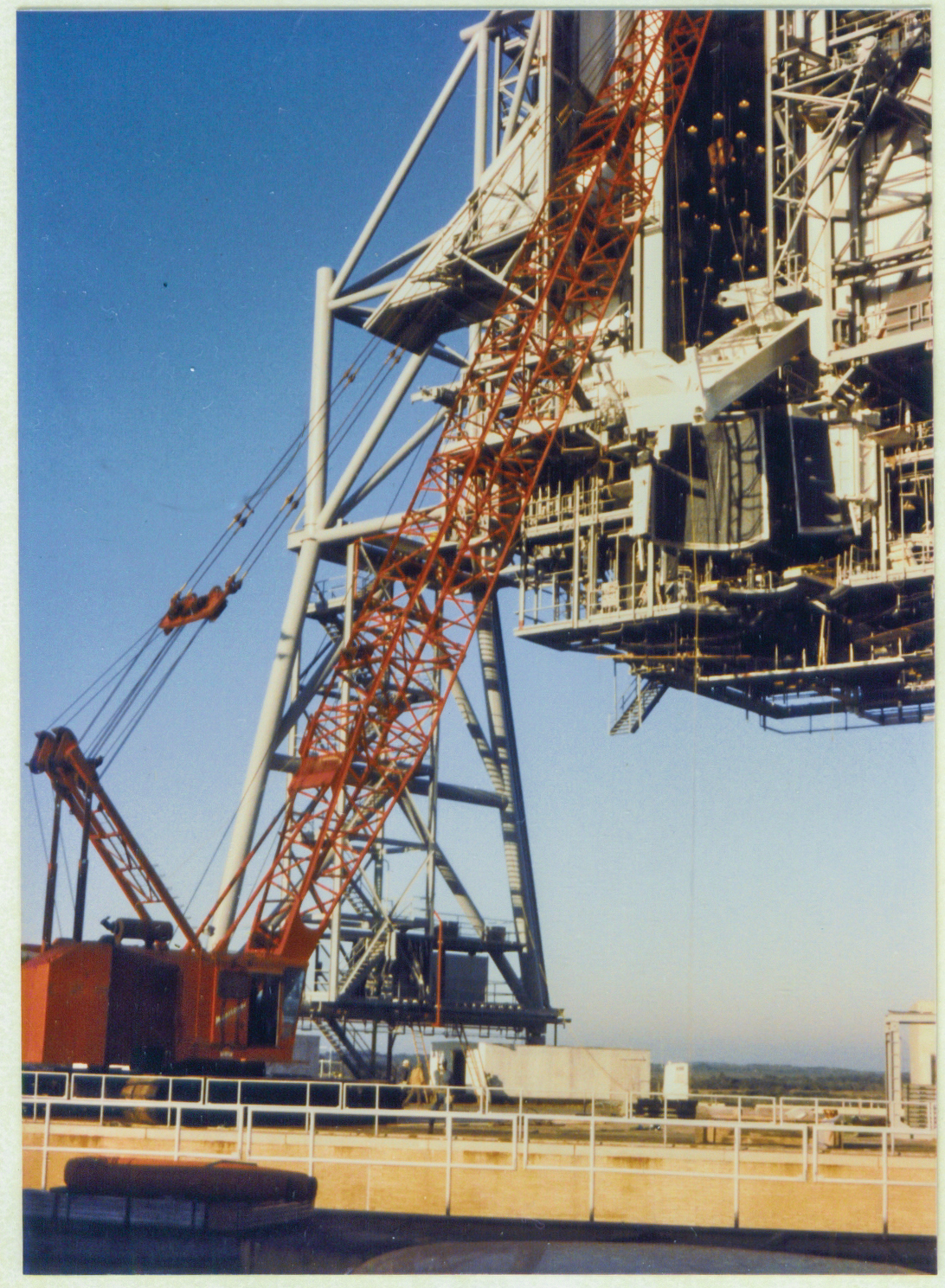
And now we're going on in, for real and for true. From this point forward, the margin for error has been reduced to zero.
From here on out, if anything goes wrong, people get hurt, people get killed, equipment gets damaged, equipment gets destroyed, or any unpleasant combination of the above that you might be so unfortunate as to suffer. We're playing for keepsies now, kids.
And of course nobody on the jobsite bats an eye at any of it. It's all in a day's work for these guys. Respect.
Bottom Right: (Full-size)
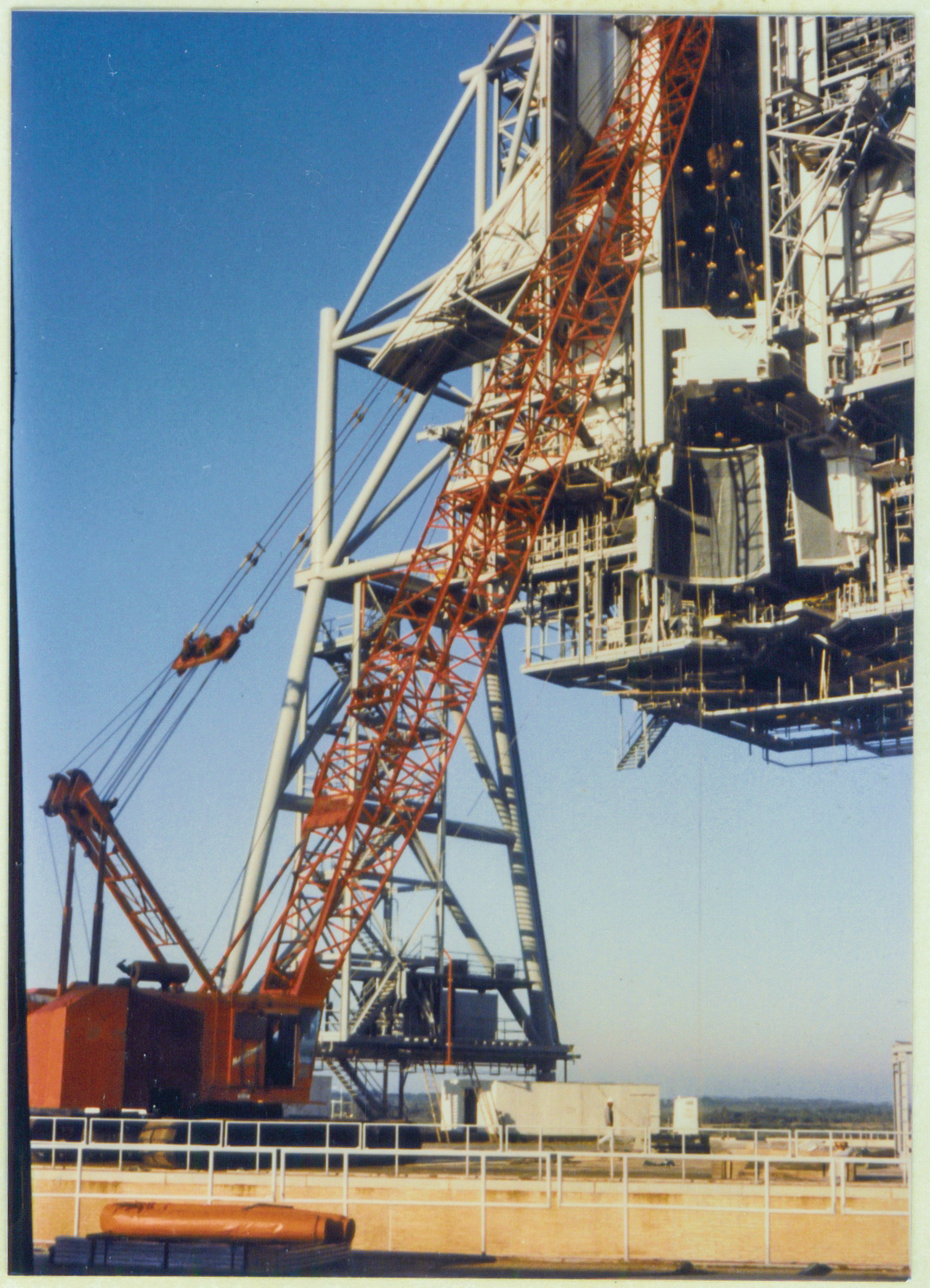
And by now the main hoist line is more or less even with the plane of the opening in the RSS, which means that the jib is already inside of the RSS. Inside the Payload Changeout Room.
The far end of the bridge beam is now in very close proximity to the PCR interior platforms, and is being worked into place from inside the dim reaches of the PCR now, by our crew of ironworkers, using come-alongs and a tugger with judiciously-placed snatch blocks, as well as continuing to be worked by the phenomenally-skilled hands of the crane operator, who can no longer even see what the hell's going on in there.
The bridge beam is now being worked around crosswise to the lifting alignment of the main hoist and jib lines, and the farther it gets away from that "natural" alignment, the greater the forces there are, that will be working to twist it back into that alignment. The beam is alive, and it has a mind of its own, and if you're not on top of that shit every second, it will suddenly swing a tremendous mass of force and energy into whatever, and whoever, is so unfortunate as to be in front of where it wants to go.
Your eye (unless it's a trained eye), would never let on that such a thing is underway. Would never let you know that invisible forces are working silently and diligently, trying to cause a catastrophe.
The ironworkers are now more or less riding this thing, and no one can get off of the ride until it is complete and the bridge beam is resting safely, tied off to the trolleys that are waiting patiently on the rails which run full-length, front-to-back, along either side of the PCR, just beneath the roof.
And the work goes on.
Return to 16streets.comACRONYMS LOOK-UP PAGEMaybe try to email me? |